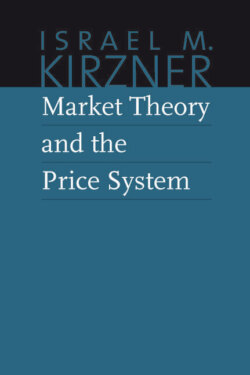Читать книгу Market Theory and the Price System - Israel M. Kirzner - Страница 24
На сайте Литреса книга снята с продажи.
THE STRUCTURE OF THE MARKET SYSTEM: HORIZONTAL RELATIONSHIPS
ОглавлениеTwo markets may be said to bear a horizontal relationship with one another, either when the goods or services sold in each of the separate markets were both bought, in part (directly or indirectly), in the same “higher” market, or when the goods or services bought in each of the separate markets are to be sold (in combination with other resources) in the same “lower” market. Thus the market where washing machines are bought and sold is related horizontally to that where automobiles are bought and sold, since the entrepreneurs in either of these markets will be bidding against one another in the same higher market—that for steel. Similarly, the labor market is related horizontally to the market where labor-saving machinery is bought and sold, since buyers in each of these markets are likely to be selling their products in the same lower market. Or again, the market in skilled labor for the production of automobiles is related horizontally to that for steel, because the resources sold in both these markets are combined and sold jointly in the automobile market; and so on.
Clearly, the decisions of buyers or sellers in any such markets will have to be between alternatives that are conditioned, not only by the decisions of competing buyers or sellers in the same market, but also, in part, by the decisions of buyers or sellers in the horizontally related markets. The price of steel to producers of washing machines will be determined partly by the strength of the demand for automobiles; the price that a skilled automobile worker can obtain for his labor will be determined in part by conditions in the steel market; and so on.
It should be clear from our discussion of the complexity of vertical market relationships that horizontal relationships, too, may be far from straightforward. Two markets may be related by different strands of connectedness, some of which may be vertical, others horizontal, in character. For example, sellers in the iron-ore market and sellers in the steel market may both buy the services of unskilled labor in the same labor market.
Several points of great importance ought to be made at this stage concerning the division of the market system into separate “markets.” It must be recognized that any such division is quite arbitrary and is made by the market theorist only as a matter of convenience. Moreover, there are significant problems where the theorist finds it convenient to stress the lack of such watertight divisions. The fact is that in the most important sense, the entire market system is one market. Each market participant is a potential customer for each good offered for sale and a potential entrepreneur in the production of every conceivable product. There is interconnectedness between every single market decision and every other single market decision made in the system. The price paid for a shoeshine at one end of the country is connected, however tenuously, with the prices paid for the rental of high-speed computers at the other end of the country, so long as both points are within a single market system. Nevertheless, there are clearly various degrees of connectedness. The price of computer rentals is obviously more directly sensitive to changes in the attitudes of buyers and sellers of computers than to changes in the tastes or incomes of customers for shoeshines. Thus, the theorist finds it convenient to mark off arbitrarily different “markets” within which the connectedness of decisions is more direct than is the case between decisions in different markets. In pointing to various structural patterns between the markets that make up the market system, the theorist is indicating the less direct, more subtle—but over the long run no less powerful—influences that different markets exercise over one another.
